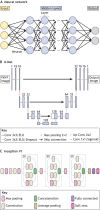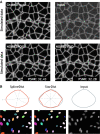Deep learning for bioimage analysis in developmental biology
- PMID: 34490888
- PMCID: PMC8451066
- DOI: 10.1242/dev.199616
Deep learning for bioimage analysis in developmental biology
Abstract
Deep learning has transformed the way large and complex image datasets can be processed, reshaping what is possible in bioimage analysis. As the complexity and size of bioimage data continues to grow, this new analysis paradigm is becoming increasingly ubiquitous. In this Review, we begin by introducing the concepts needed for beginners to understand deep learning. We then review how deep learning has impacted bioimage analysis and explore the open-source resources available to integrate it into a research project. Finally, we discuss the future of deep learning applied to cell and developmental biology. We analyze how state-of-the-art methodologies have the potential to transform our understanding of biological systems through new image-based analysis and modelling that integrate multimodal inputs in space and time.
Keywords: Bioimaging; Deep learning; Image analysis; Microscopy; Neural network.
© 2021. Published by The Company of Biologists Ltd.
Conflict of interest statement
Competing interests The authors declare no competing or financial interests.
Figures


Similar articles
-
Open-source deep-learning software for bioimage segmentation.Mol Biol Cell. 2021 Apr 19;32(9):823-829. doi: 10.1091/mbc.E20-10-0660. Mol Biol Cell. 2021. PMID: 33872058 Free PMC article.
-
On the objectivity, reliability, and validity of deep learning enabled bioimage analyses.Elife. 2020 Oct 19;9:e59780. doi: 10.7554/eLife.59780. Elife. 2020. PMID: 33074102 Free PMC article.
-
Deciphering tissue morphodynamics using bioimage informatics.Philos Trans R Soc Lond B Biol Sci. 2017 May 19;372(1720):20150512. doi: 10.1098/rstb.2015.0512. Philos Trans R Soc Lond B Biol Sci. 2017. PMID: 28348249 Free PMC article. Review.
-
From pixels to insights: Machine learning and deep learning for bioimage analysis.Bioessays. 2024 Feb;46(2):e2300114. doi: 10.1002/bies.202300114. Epub 2023 Dec 6. Bioessays. 2024. PMID: 38058114 Review.
-
Bi-channel image registration and deep-learning segmentation (BIRDS) for efficient, versatile 3D mapping of mouse brain.Elife. 2021 Jan 18;10:e63455. doi: 10.7554/eLife.63455. Elife. 2021. PMID: 33459255 Free PMC article.
Cited by
-
DeXtrusion: automatic recognition of epithelial cell extrusion through machine learning in vivo.Development. 2023 Jul 1;150(13):dev201747. doi: 10.1242/dev.201747. Epub 2023 Jun 30. Development. 2023. PMID: 37283069 Free PMC article.
-
Novel imaging and biophysical approaches to study tissue hydraulics in mammalian folliculogenesis.Biophys Rev. 2024 Oct 7;16(5):625-637. doi: 10.1007/s12551-024-01231-4. eCollection 2024 Oct. Biophys Rev. 2024. PMID: 39618785 Free PMC article. Review.
-
3D visualization of uterus and ovary: tissue clearing techniques and biomedical applications.Front Bioeng Biotechnol. 2025 Jul 7;13:1610539. doi: 10.3389/fbioe.2025.1610539. eCollection 2025. Front Bioeng Biotechnol. 2025. PMID: 40692613 Free PMC article. Review.
-
A Systematic, Open-Science Framework for Quantification of Cell-Types in Mouse Brain Sections Using Fluorescence Microscopy.Front Neuroanat. 2021 Dec 6;15:722443. doi: 10.3389/fnana.2021.722443. eCollection 2021. Front Neuroanat. 2021. PMID: 34949993 Free PMC article.
-
Machine learning approaches for image classification in developmental biology and clinical embryology.Development. 2025 Feb 15;152(4):DEV202066. doi: 10.1242/dev.202066. Epub 2025 Feb 17. Development. 2025. PMID: 39960146 Free PMC article. Review.
References
-
- Adebayo, J., Gilmer, J., Muelly, M., Goodfellow, I., Hardt, M. and Kim, B. (2018). Sanity checks for saliency maps. In Proceedings of NeurIPS 2018.
-
- Barber, R. F. and Candès, E. J. (2019). A knockoff filter for high-dimensional selective inference. Annals of Statistics 47, 2504-2537. 10.1214/18-AOS1755 - DOI
Publication types
MeSH terms
Grants and funding
LinkOut - more resources
Full Text Sources
Research Materials

